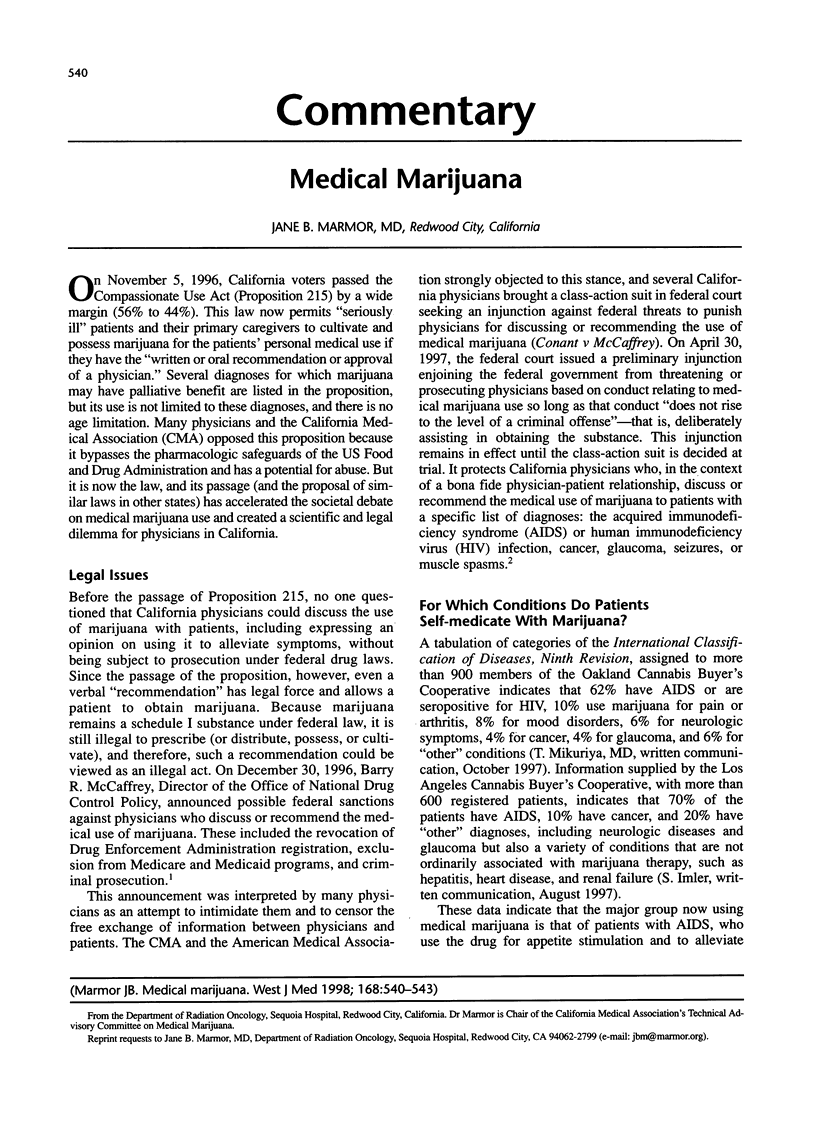Abstract
Although many clinical studies suggest the medical utility of marijuana for some conditions, the scientific evidence is weak. Many patients in California are self-medicating with marijuana, and physicians need data to assess the risks and benefits. The only reasonable solution to this problem is to encourage research on the medical effects of marijuana. The current regulatory system should be modified to remove barriers to clinical research with marijuana. The NIH panel has identified several conditions for which there may be therapeutic benefit from marijuana use and that merit further research. Marijuana should be held to the same evaluation standards of safety and efficacy as other drugs (a major flaw in Proposition 215) but should not have to be proved better than current medications for its use to be adopted. The therapeutic window for marijuana and THC between desired effect and unpleasant side effects is narrow and is a major reason for discontinuing use. Although the inhaled route of administration has the benefit of allowing patients to self-titrate the dose, the smoking of crude plant material is problematic. The NIH panel recommended that a high priority be given to the development of a controlled inhaled form of THC. The presence of a naturally occurring cannabinoid-receptor system in the brain suggests that research on selective analogues of THC may be useful to enhance its therapeutic effects and minimize adverse effects.
Full text
PDF



Selected References
These references are in PubMed. This may not be the complete list of references from this article.
- Adams I. B., Martin B. R. Cannabis: pharmacology and toxicology in animals and humans. Addiction. 1996 Nov;91(11):1585–1614. [PubMed] [Google Scholar]
- Beal J. E., Olson R., Laubenstein L., Morales J. O., Bellman P., Yangco B., Lefkowitz L., Plasse T. F., Shepard K. V. Dronabinol as a treatment for anorexia associated with weight loss in patients with AIDS. J Pain Symptom Manage. 1995 Feb;10(2):89–97. doi: 10.1016/0885-3924(94)00117-4. [DOI] [PubMed] [Google Scholar]
- Chang A. E., Shiling D. J., Stillman R. C., Goldberg N. H., Seipp C. A., Barofsky I., Simon R. M., Rosenberg S. A. Delata-9-tetrahydrocannabinol as an antiemetic in cancer patients receiving high-dose methotrexate. A prospective, randomized evaluation. Ann Intern Med. 1979 Dec;91(6):819–824. doi: 10.7326/0003-4819-91-6-819. [DOI] [PubMed] [Google Scholar]
- Devane W. A., Hanus L., Breuer A., Pertwee R. G., Stevenson L. A., Griffin G., Gibson D., Mandelbaum A., Etinger A., Mechoulam R. Isolation and structure of a brain constituent that binds to the cannabinoid receptor. Science. 1992 Dec 18;258(5090):1946–1949. doi: 10.1126/science.1470919. [DOI] [PubMed] [Google Scholar]
- Foltin R. W., Fischman M. W., Byrne M. F. Effects of smoked marijuana on food intake and body weight of humans living in a residential laboratory. Appetite. 1988 Aug;11(1):1–14. doi: 10.1016/s0195-6663(88)80017-5. [DOI] [PubMed] [Google Scholar]
- Gorter R., Seefried M., Volberding P. Dronabinol effects on weight in patients with HIV infection. AIDS. 1992 Jan;6(1):127–127. doi: 10.1097/00002030-199201000-00018. [DOI] [PubMed] [Google Scholar]
- Gralla R. J., Tyson L. B., Bordin L. A., Clark R. A., Kelsen D. P., Kris M. G., Kalman L. B., Groshen S. Antiemetic therapy: a review of recent studies and a report of a random assignment trial comparing metoclopramide with delta-9-tetrahydrocannabinol. Cancer Treat Rep. 1984 Jan;68(1):163–172. [PubMed] [Google Scholar]
- Greenberg H. S., Werness S. A., Pugh J. E., Andrus R. O., Anderson D. J., Domino E. F. Short-term effects of smoking marijuana on balance in patients with multiple sclerosis and normal volunteers. Clin Pharmacol Ther. 1994 Mar;55(3):324–328. doi: 10.1038/clpt.1994.33. [DOI] [PubMed] [Google Scholar]
- Hepler R. S., Frank I. R. Marihuana smoking and intraocular pressure. JAMA. 1971 Sep 6;217(10):1392–1392. [PubMed] [Google Scholar]
- Herzberg U., Eliav E., Bennett G. J., Kopin I. J. The analgesic effects of R(+)-WIN 55,212-2 mesylate, a high affinity cannabinoid agonist, in a rat model of neuropathic pain. Neurosci Lett. 1997 Jan 17;221(2-3):157–160. doi: 10.1016/s0304-3940(96)13308-5. [DOI] [PubMed] [Google Scholar]
- Merritt J. C., Crawford W. J., Alexander P. C., Anduze A. L., Gelbart S. S. Effect of marihuana on intraocular and blood pressure in glaucoma. Ophthalmology. 1980 Mar;87(3):222–228. doi: 10.1016/s0161-6420(80)35258-5. [DOI] [PubMed] [Google Scholar]
- Noyes R., Jr, Brunk S. F., Avery D. A., Canter A. C. The analgesic properties of delta-9-tetrahydrocannabinol and codeine. Clin Pharmacol Ther. 1975 Jul;18(1):84–89. doi: 10.1002/cpt197518184. [DOI] [PMC free article] [PubMed] [Google Scholar]
- Schwartz R. H., Voth E. A., Sheridan M. J. Marijuana to prevent nausea and vomiting in cancer patients: a survey of clinical oncologists. South Med J. 1997 Feb;90(2):167–172. doi: 10.1097/00007611-199702000-00001. [DOI] [PubMed] [Google Scholar]
- Ungerleider J. T., Andrysiak T., Fairbanks L., Goodnight J., Sarna G., Jamison K. Cannabis and cancer chemotherapy: a comparison of oral delta-9-THC and prochlorperazine. Cancer. 1982 Aug 15;50(4):636–645. doi: 10.1002/1097-0142(19820815)50:4<636::aid-cncr2820500404>3.0.co;2-4. [DOI] [PubMed] [Google Scholar]
- Vinciguerra V., Moore T., Brennan E. Inhalation marijuana as an antiemetic for cancer chemotherapy. N Y State J Med. 1988 Oct;88(10):525–527. [PubMed] [Google Scholar]
- Voth E. A., Schwartz R. H. Medicinal applications of delta-9-tetrahydrocannabinol and marijuana. Ann Intern Med. 1997 May 15;126(10):791–798. doi: 10.7326/0003-4819-126-10-199705150-00008. [DOI] [PubMed] [Google Scholar]


